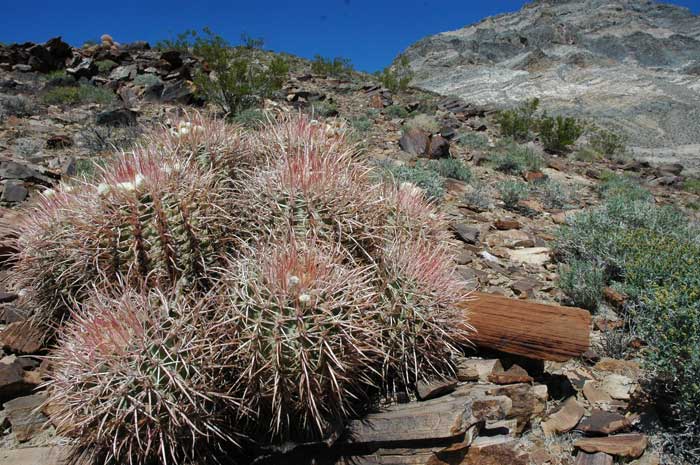^Before...Cottontop cactus (Echinocactus polycephalus).
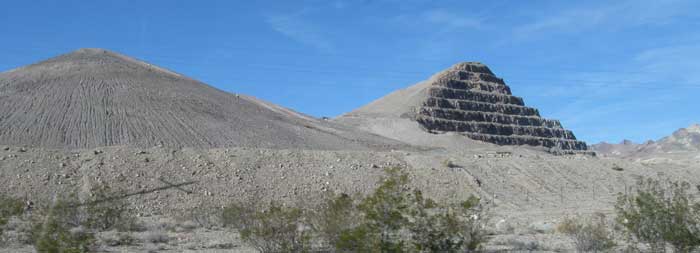
^After...?
Mine toxins
From page 1 - A heap leach facility, including a 56-acre heap leach pad, solution collection system, process tank and pond, and a carbon adsorption circuit will be built nearby on the fan. Leaching would be accomplished with a dilute sodium cyanide solution. Caustic soda or lime would be added to maintain the pH of the solution between 10.5 and 11.0. A liner would theoretically keep the solution from seeping into the watertable under the ponds.
The solution would then be routed to a tank which contains the carbon circuit. Once the carbon is loaded with gold and silver, the loaded carbon would be transferred into containers, and transported to CRRC’s CR Briggs Corporation Briggs Mine in Panamint Valley (Inyo County, California) for stripping, refining, and carbon reactivation. CRRC says it will use process fluid storage tanks as an alternative to the conventional double pond system, thereby reducing the potential area of desert disturbance for process pond construction, and reducing evaporation of the process fluid.
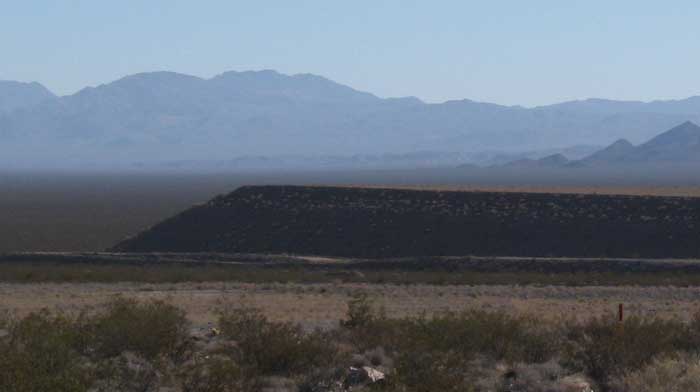
^Leach pad at Bullfrog Mine near Beatty, Nevada. The Barrick Bullfrog Mine open pit-cyanide vat-leach operation ended mining and milling operations in 1999 and began site closure. In 2005 Barrick placed dirt on top of this pad to try to contain cyanide-laden dust from blowing over the area.
The outdated General Mining Law of 1872 allows CRRC to extract the metals on their claims.
The EA does not describe what route that the material will be hauled to the Briggs Mine. Will the material be going through the state highway through Death Valley National Park? Will it be going through Shoshone California or Lida Nevada? Have the local communities been consulted?
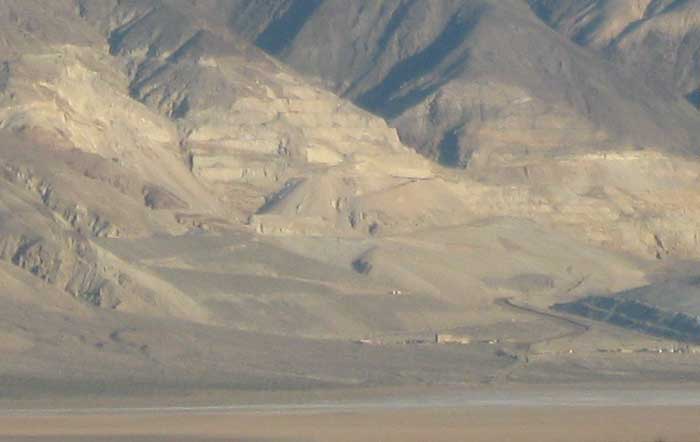
^Briggs Mine in Panamint Valley, Inyo County, California.
Toxins:
1. Mercury pollution
2. Cyanide contamination
3. Acid mine drainage
1. Mercury pollution:
Particulate emissions from the Reward project mining and ore crushing would amount to about 65 tons per year. Truck hauling of ore and waste, and wind erosion are the other primary emission sources.
We request a study be done to find out of the gold ore in the Bare Mountains contains mercury, and what the air emissions are from ore processing that would take place both at the Reward site and at the Briggs Mine.
Gold Mines are a source of mercury air pollution and are the fifth largest source of mercury air emissions in the U.S. Nevada mines produce fully 25% of all mercury air emissions west of Texas, but there are no federal regulations requiring gold mines to control their mercury emissions (TRI Data, Environmental Protection Agency, 2002). Most mercury emissions come from gold mines in northern Nevada because these mines are located in an area where gold ore also contains mercury. The Goldstrike Mine, located in northern Nevada, is the single largest source of mercury air emissions in the U.S. It emitted 1438 pounds of mercury in 2003 (2003 Program Summary Report to NDEP from Barrick Goldstrike, July 2004). Researchers at Salmon Falls Creek Reservoir in southern Idaho, have recently detected mercury levels 150 times higher than those found in lakes in the northeast U.S.3 Mike Abbott, an atmospheric scientist with the Idaho National Laboratory (INL), found that mercury levels in the region increased as much as 70 percent when winds blew from the Northern Nevada direction (Mercury rising? Studies reveal high mercury levels at Salmon Falls Reservoir, The Times News, November 6, 2005).
The mercury is released into the air when the ore is heated during the gold extraction process. Most of the mercury air emissions from Nevada gold mines are released by thermal processes, such as ore roasters or autoclaves. Under these processes, the mercury residing in the ore is released into the air when the ore is heated to extract the gold. Fugitive emissions from waste rock piles or tailings may also contribute mercury into the air. Air emissions from these mines may travel great distances, affecting states throughout the Intermountain West.
Mercury in the air eventually ends up in rivers, wetlands, and lakes, and ultimately in the fish we eat. Aquatic bacteria convert mercury to methlymercury, an organic form that is toxic to life. As methylmercury enters the food chain, it becomes progressively more concentrated with each step up the food chain. So fish at the top of the food chain -- predatory fish like bass and tuna -- can contain mercury in their muscle tissue that is much higher than the mercury concentration in the surrounding water. Since mercury is tightly bound to proteins in all fish tissue, including muscle, there is no method of cooking or cleaning that will reduce the amount of mercury in a meal. In the Oasis Valley and Beatty area many people go fishing for local bass, and eat them. We want to know what increased health risks are potential for the new gold mining that will take place at Reward Mine.
Preliminary estimates of mercury levels in hair and blood samples from the 1999 National Health and Nutrition Examination Survey suggests that approximately 10% of U.S. women have mercury levels within one tenth of potentially hazardous levels (http://www.cdc.gov/mmwr/preview/mmwrhtml/mm5008a2.htm). Exposure to mercury can cause significant neurological and developmental problems. EPA officials also say there is growing evidence that methylmercury exposure can have adverse cardiovascular effects for adults, resulting in elevated blood pressure and incidence of heart attack.
The Coeur Rochester, Newmont Lone Tree and Glamis Gold mines in northern Nevada have grossly under-reported their mercury air emissions. Mining companies are required to report their emissions annually to the EPA's Toxic Release Inventory (TRI) so that the public has access to information about the amount of toxic mercury released in and around their communities. According to TRI data, these three gold mines have reported zero, or relatively low, mercury air emissions every year since 1998. Yet, Great Basin Mine Watch, Idaho Conservation League, and EARTHWORKS recently obtained new information from the Nevada Department of Environmental Protection (NDEP), which indicates that these mines have vastly understated their emissions. (Great Basin Mine Watch, EARTHWORKS, Idaho Conservation League, 8/14/2006). According to recent information obtained from NDEP, two major gold mines in northern Nevada have dramatically increased their reported mercury air emissions from 2004 to 2005. The Twin Creeks Mine has nearly doubled its reported emissions, and the Gold Quarry mine has more than tripled its reported emissions. Together the two mines reported more than 700 pounds more mercury in 2005 than 2004; the equivalent of nearly 3 average-sized coal fire power plants. Total air emissions for the 2 mines in 2005 top 1,200 pounds. (Great Basin Mine Watch, EARTHWORKS, Idaho Conservation League, 8/14/2006)(Source: www.earthworks.org)
Nevada has a state program that is beginning to work with mines to control mercury emission. But soon the federal Environmental Protection Agency will decide if the state program is strong enough and if it needs to intervene in regulating gold mines. The EPA is acting under a court order last fall in a lawsuit over clean-air standards. The Nevada Mining Association said it will fight the EPA. (See the story in the Las Vegas Sun >>here.)
We want to know what the estimated air emissions of mercury will be for ore processing at the Reward and Briggs sites, measured at the site and at distances such as at Beatty.

2. Cyanide contamination:
Sodium cyanide shipments would be transported by truck on State Highway 95 from northern Nevada, either Winnemucca or Carlin. Two sodium cyanide deliveries per month would arrive by tanker truck. "The calculated number of accidents
would be 0.09 over the five year active mining period. Spills near water could have immediate adverse effects on the water quality and aquatic resources. Storage on site would comply with state requirements. Tanks and vessels would be placed on a plastic lined containment surface with interior sumps to route any spilled solutions to lined collection areas."
"Proposed mining at the Reward Mine would likely increase the emissions of ... hydrocarbons," says the EA. We wonder how this will affect carbon emissions that lead to global warming?
"The heap leach pad would be lined to maintain containment of process fluids." Theoretically this would "forever" contain the cyanide residue from any groundwater, but we are skeptical in the long term.
CRRC says it will use process fluid storage tanks as an alternative to the conventional double pond system, thereby reducing the potential area of desert disturbance for process pond construction, and reducing evaporation of the process fluid.
Permanent closing of the heap leach pond containing "spent ore" and cyanide would involve covering the pad with more dirt, recirculating heap draindown fluid to lower the concentration of pH and cyanide, "filtration of the recirculated fluid via carbon adsorption to further reduce constituent
levels," and "use of the event pond to create an evapotranspiration basin (ET Cell) to contain and evaporate the long-term heap draindown." The EA admits that some flow might occur through the spent ore during high rainfall periods.
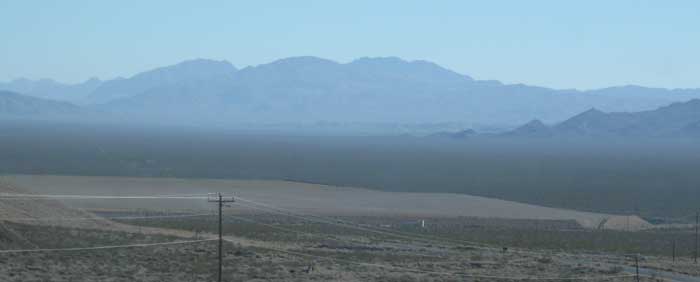
^Closed leach pads at Bullfrog Mine, Beatty.
Containers with cyanide residue would be rinsed off, allowing small amounts of this poison into the environment: "Empty steel process fluid tanks would be triple rinsed with fresh water. The tanks would then be removed from the site and transported to another CRRC operation, offered for sale as surplus equipment, or the steel would be recycled. If CRRC has no other use for the tanks and market conditions do not warrant economic realization from sale or recycling of the tanks, they would then be cut into pieces and disposed of in the onsite Class III waivered landfill. Containment areas within which the tanks were located would also be rinsed and concrete containment walls and/or synthetic liner containment pieces would be broken and cut up and buried in place or in
the onsite landfill."
Dissolved hydrogen cyanide evaporates. Will cyanide in the air be monitored often by the leach facility? Human health may be affected at air concentrations of over 5 cubic milligrams/kg of cyanide (Handbook of Chemical Risk Assessment by Ronald Eisler, CRC Press, 2000). We would like to know what measurements will find at the Reward Mine.
Cyanide is acutely toxic to humans. Liquid or gaseous hydrogen cyanide and alkali salts of cyanide can enter the body through inhalation, ingestion or absorption through the eyes and skin. The rate of skin absorption is enhanced when the skin is cut, abraded or moist; inhaled salts of cyanide are readily dissolved and absorbed upon contact with moist mucous membranes. The toxicity of gaseous hydrogen cyanide is 100-300 parts per million. Inhalation of cyanide in this range results in death within 10-60 minutes, with death coming more quickly as the concentration increases.(http://www.cyanidecode.org/cyanide_environmental.php). We want to know the potential airborne contamination from mine tailings.
Will plastic sheeting be used to stop avian kills, instead of a net, which might allow small wildlife to access the ponds? This is done at some mines according to Handbook of Chemical Risk Assessment by Ronald Eisler.
In Ely, NV, the Alligator Ridge Mine operated by USMX released 200,000 gallons of cyanide in 1983. (Environmental Protection Agency: metminsnpt2)
Cyanide is used in mining to chemically extract the last remnants of gold. But there are no fool-proof protections against cyanide leaks or spills, even when modern mining techniques are used, and point to catastrophic mining accidents worldwide that have polluted waterways and destroyed habitat. "It implies to the general public that nothing ever escapes, and I've never seen a site where that's true," said Robert Moran, a Golden, Colorado-based geochemist and hydrogeologist who consults governments, industrial clients and public-interest groups on mining projects worldwide.
In 2001, the mining industry made up 45 percent of all chemical releases in the United States - the largest of any industry that year - with 2.8 billion pounds of toxic pollutants released, according to the U.S. Environmental Protection Agency's Toxics Release Inventory. In 2000, the EPA identified 40% of the headwaters of western watersheds as having sections polluted by mining.
One teaspoon of a 2 percent cyanide solution can kill a person, but only a microscopic amount of cyanide in water is lethal to fish, birds, and other wildlife. And, although chemically it can break down, it can also take on altered forms capable of wreaking havoc on plant and animal life, said Moran, author of "De-Coding Cyanide: An Assessment of Gaps in Cyanide Regulation at Mines."
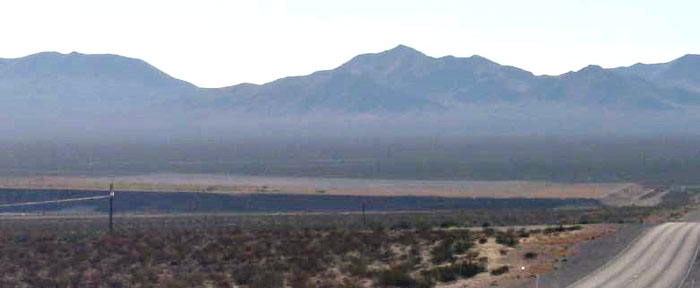
^Leach pad at Bullfrog Mine, Beatty. Cyanide residue is buried here still, 10 years after the mine closed down operations.
Many mines - whether an underground operation or an open pit operation - impound tailings in ponds. The ponds have liners, but liners almost always fail, causing leaks, scientists interviewed for this story say. Sodium cyanide dissolves gold into a chemical solution from which the gold is later recovered. Cyanide can be reused, although the cyanidation process requires continually adding more cyanide. In the foreword to Moran's 1998 paper, "Cyanide Uncertainties: Observations on the Chemistry, Toxicity and Analysis of Cyanide in Mining-Related Waters," Stephen D'Esposito of EARTHWORKS wrote that the mining industry's use of cyanide makes it possible to "mine low-grade ore bodies for microscopic flecks of gold ... and still turn a profit." But, he goes on, "The mining industry and regulators claim that cyanide rapidly breaks down into harmless compounds, but this is only part of the cyanide story. The rest of the story is that cyanide also breaks down into compounds that are potentially toxic to fish and other aquatic organisms. Many of these compounds are generally less toxic than the original cyanide, but may persist for long periods of time. And there is evidence that some of these compounds are stored, or bioaccumulate, in plant and fish tissue." Moran's paper points to a series of recent cyanide accidents in the West, including at the Summitville gold mine in Colorado, which was abandoned and became a federal Superfund site after a cyanide spill contaminated 17 miles of the Alamosa River; the Zortman-Landusky gold mine in Montana, which closed after "repeated leaks and discharges of cyanide solution" killed wildlife and contaminated streams and groundwater; the Gold Quarry mine in Nevada, which leaked 245,000 gallons of cyanide-laden waste into two creeks; and the McCoy/Cove gold mine in Nevada, where nearly 900 pounds of cyanide were released.
In 1998, voters in Montana banned the use of cyanide in open-pit mines (the Idaho-Maryland is an underground mine). Jim Jensen, a former Montana lawmaker who authored Initiative 137, which passed with 52 percent of the vote and has withstood court appeals, said the ballot measure was a result of extensive environmental damage from mining. Open pit mines have simply caused more problems in the Big Sky state than underground mines, he said. Mining experts and scientists generally refer to two kinds of gold-leaching processes that use cyanide. Heap leaching involves spraying cyanide on piles (heaps) of ore out in the open air and seeking to capture any runoff with a liner. Vat leaching involves mixing cyanide with the ore in a large container. I-137 bans heap and vat leaching at open-pit mines.
Emgold's gold mine plans in California for the Idaho-Montana mine at Grass Valley include dissolving gold and other metals in the concentrate by the cyanide, creating a solution that would be put through an electrowinning circuit from which the gold would be recovered and placed onto stainless steel sheets. The gold would be scraped off the sheets, put into an electric furnace and melted into 50- to 60-pound gold doré bricks that Witte said will contain 92 to 93 percent gold. The bricks would later be trucked to a refinery.
Meanwhile, the cyanide would be pumped back into the cyanidation reactor. "It is a closed loop, and it is completely enclosed and encased," Witte said. The company would use sulfuric acid to destroy most of the cyanide before the tailings are hauled to the ceramics plant. "There may be some trace amounts of cyanide in the tailings ...," Emgold's application says.
We would like to know if this is a similar process to what the Reward Mine will do, and if there will be trace amounts of cyanide in the tailings and waste rock dumped onto the hills by the pit. This would potentially get into the Amargosa River from flash floods. We noticed an recently active ephemeral wash coming out of a canyon in the Bare Mountains that goes within 500 meters of the Reward main pit and planned waste rock dump area. This wash connects to the Amargosa River.
(Source: GOLDEN GAMBLE IN GRASS VALLEY: A LEGACY OF RISK, By: Doug Mattson, YubaNet.com, Published: August 16, 2005 at 13:39)
The EA states that during reclamation, the heap leach tanks would be allowed to evaporate, and the remaining sludge would be placed on the heap leach pad "to remain in containment." Please clarify what this means. Does this sludge have cyanide? Will cyanide sludge be buried on site?
According to the EPA Metal Mining Sector Notebook September 1995, much of the heavy metals and cyanide can be removed in tailings management through the use of ion exchange, heavy metal removal and cyanide destruction systems, precipitation of heavy metals using lime, oxidation of cyanide using sodium hypochlorine, then electrolysis, and filtration through a high flow rate sand filter. Will CRRC be required to do any of these methods?

^Ten-year-old waste rock dump at Bullfrog Mine.
3. Acid mine drainage:
pp. 67-68: "NDEP guidelines suggest that any material with an AGP/ANP ratio of less than 1.2 may be potentially acid generating. All of the waste rock units tested to date have an AGP/ANP of 3.0 or greater, with the exception of two small samples of the Sterling Formation. These two samples appear to be anomalies that are associated with local mineralized zones. Therefore, acid generation from Reward Project waste rock is unlikely. The Project is located in a low precipitation/high evaporation area. Therefore, drainage from infiltrating meteoric water through the waste rock dumps is not projected to occur. No groundwater or springs have been identified during reconnaissance and condemnation drilling in the entire Reward Project area. Therefore, no degradation of the groundwater is anticipated from the construction or location of the waste rock dumps." p. 13: <0.01 % sulphur in rocks measured at Reward site. "It is noted that the Glamis acid/base accounting results from analyses of the Sterling Formation indicated a lower Acid Neutralizing Potential..." which as considered "anomalous."
Even low sulfide ore with significant amount of calcium carbonate can produce acid over long periods of time. The Zortman-Landusky in Montana, which had sulfide content as low as .2 to .3 % sulfide and is now a federal Superfund cleanup site. The mine's acid potential can outlast its carbonates and other neutralizing minerals. Carbonate rocks broken up into small pieces and exposed to the air dissolve at a faster rate. If there is a lot of carbonate around, it could neutralize the acid for a certain amount of time. Acid-based accounting tests often don't take this into account, how quickly each of these minerals will weather over time. (Source: GOLDEN GAMBLE IN GRASS VALLEY: A LEGACY OF RISK By: Doug Mattson, YubaNet.com, Published: August 16, 2005) According to the EPA, in 1990 acid drainage occurred at the Rain Facility, Newmont Mining Co., Carlin, NV (EPA Metal Mining Sector Notebook September 1995).
We would like a study to be done to examine the long-term effects of acid formation and possible contamination of the Amargosa River and groundwater.
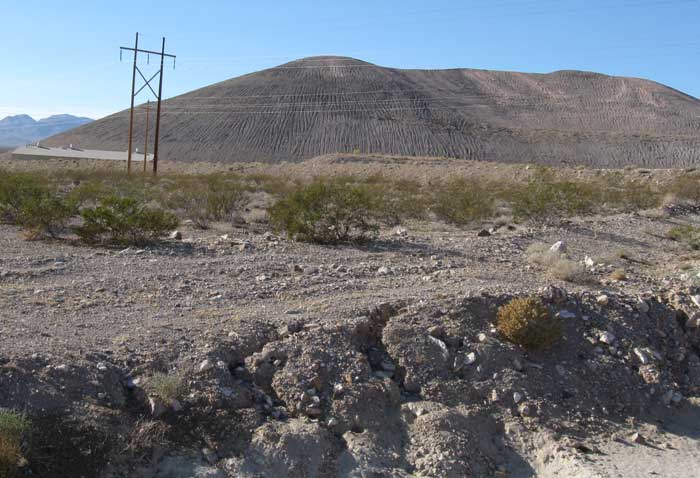
^Bullfrog Mine waster rock dump. The State of Nevada declared that "most of the mine disturbance has been reseeded and revegetation has been successful" here (Nevada State Budget Office 2006).
The event pond would be fenced to exclude terrestrial wildlife access, and netted to preclude avian access. We recommended the use of solid plastic sheets over the dangerous cyanide leach ponds to prevent any birds or lizards from dying.
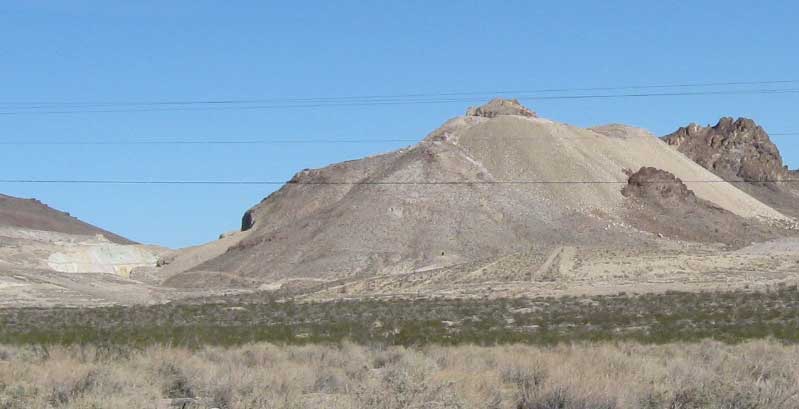
^Bullfrog Mine near Rhyolite, Nevada. Pit on left, waste rock dump on right.
All this for Jewelry?
HOME..........Page 1..........Mining News
